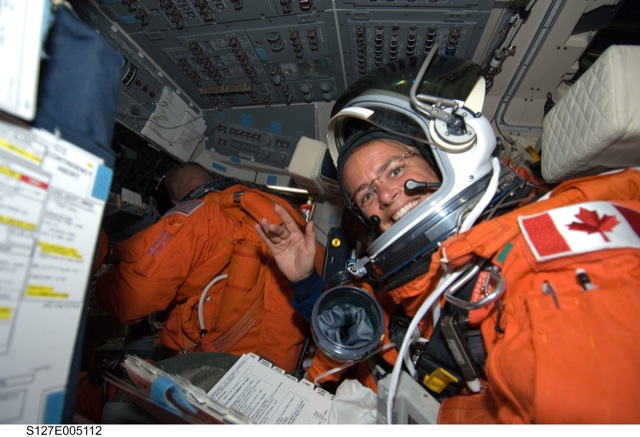

NAME: Julie Payette
Canadian Space Agency Astronaut – Active
PERSONAL DATA:
Born October 20, 1963, in Montréal, Quebec Married with 2 children Ms. Payette enjoys running, skiing, racquet sports and scuba diving. She has a multi-engine commercial pilot license with instrument and float ratings. Ms. Payette is fluent in French and English, and converses in Spanish, Italian, Russian and German. She plays the piano and has sung with the Chamber Choir of the Orchestre symphonique de Montréal, the Piacere Vocale in Basel, Switzerland, and the Tafelmusik Baroque Orchestra Choir in Toronto
EXPERIENCE:
Before joining the space program, Ms. Payette conducted research in computer systems, natural language processing, automatic speech recognition and the application of interactive technologies in space. She was system engineer with IBM Canada (1986-1988); research assistant at the University of Toronto (1988-1990); visiting scientist at the IBM Research Laboratory, in Zurich, Switzerland (1991). She was research engineer for the Speech Research Group, Bell-Northern Research/Nortel, Montréal (1992).
SPACE EXPERIENCE:
In June 1992, the Canadian Space Agency (CSA) selected Ms. Payette from 5,330 applicants to become one of four astronauts. After her basic training in Canada, she worked as a technical advisor for the Mobile Servicing System (MSS), an advanced robotics system contributed by Canada to the International Space Station. Ms. Payette reported to the NASA Johnson Space Center in Houston, Texas in August 1996. She completed initial astronaut training in April 1998 and was assigned to work on technical issues in robotics for the Astronaut Office. Ms. Payette has been the Chief Astronaut for the Canadian Space Agency since 2002. For her technical assignment, she works as a CapCom (Capsule Communicator) at the Mission Control Center in Houston. The CapCom is responsible for all communications between ground controllers and the astronauts in flight. In 2006, Ms. Payette was CapCom for mission STS-121 on Space Shuttle Discovery.
SPACE FLIGHTS:
STS-96
Julie Payette flew on Space Shuttle Discovery from May 27 to June 6, 1999 as a crewmember of STS-96. During the mission, the crew performed the first manual docking of the Shuttle to the International Space Station (ISS), and delivered four tons of supplies to the Station. Ms. Payette served as a mission specialist, was responsible for the Station systems and operated the Canadarm robotic arm while in orbit. The STS-96 mission was accomplished in 153 orbits of the Earth, traveling more than six million kilometres in 9 days, 19 hours and 13 minutes. Ms. Payette was the first Canadian to participate in an ISS assembly mission and to board the Space Station.
STS-127
Julie Payette flew on the shuttle Endeavour as the flight engineer and mission specialist 2. The primary purpose of the STS-127 mission was to deliver and install the final two components of the Japanese Experiment Module: the Exposed Facility (JEM EF), and the Exposed Section of the Experiment Logistics Module (ELM-ES). When Endeavour docked with ISS, it set a record for the most humans in space at the same time in the same vehicle. In total thirteen astronauts & cosmonauts were in the International Space Station (ISS) at the same time. This also tied the record of thirteen people in space at any one time. This was also a record for Canada. For the first time we had two Canadians in space at the same time. While Julie was flying mission STS-127, Canadian astronaut Bob Thirsk was living onboard the ISS.
CURRENT STATUS:
Julie Payette is on active status at the NASA Johnson Space Center.
NOVEMBER 2009